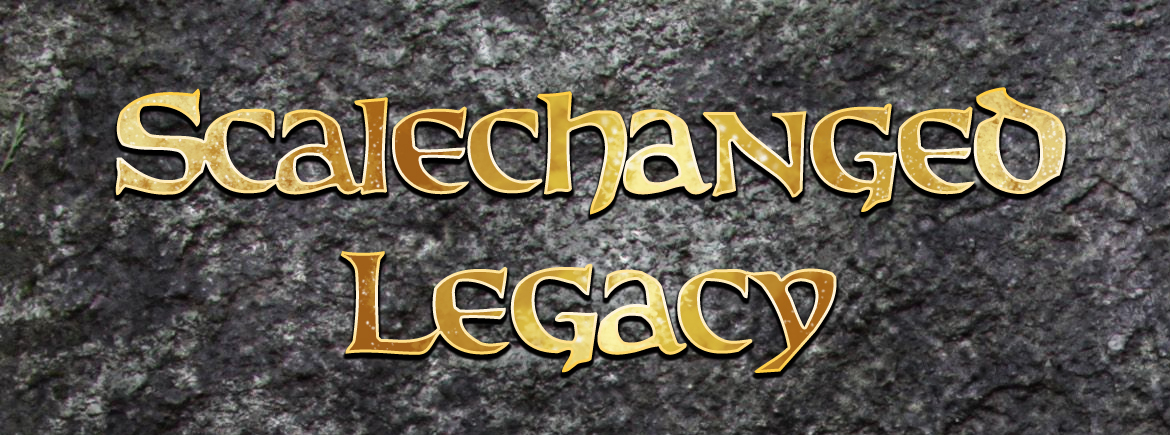Dragonborn
Dragonborn are tall, draconic humanoids. They were originally human, transformed by dragons in ages past to serve as servants and soldiers in the dragons' war against the elves. Today, they are the primary and dominant species in the world.
Dragonborn are typically strong and tall, with tough scales. They occupy every level of dragonfolk society, both peasant and noble.
Dragonborn
Creature Type. You are a Humanoid (dragonborn).
Scalechanged Ancestry. You descend from humans who were transformed into dragonborn by the Scalechange. Choose one type of dragon from the Scalechanged Ancestry table. Your breath weapon and other traits are determined by the dragon type, as shown in the table.
| Dragon | Damage Type | Breath Weapon |
| Black | Acid | 5 by 30 ft. line |
| Blue | Lightning | 5 by 30 ft. line |
| Green | Poison | 15 ft. cone |
| Red | Fire | 15 ft. cone |
| White | Cold | 15 ft. cone |
Breath Weapon. When you take the Attack action on your turn, you can replace one of your attacks with an exhalation of magical energy in an area determined by your Scalechanged ancestry (see the table above). Each creature in that area must make a Dexterity saving throw (DC = 8 + your Constitution modifier + your proficiency bonus). On a failed save, the creature takes 1d10 damage of the type associated with your Scalechanged Ancestry. On a successful save, it takes half as much damage. This damage increases by 1d10 when you reach 5th level (2d10), 11th level (3d10), and 17th level (4d10).
You can use your Breath Weapon a number of times equal to your proficiency bonus, and you regain all expended uses when you finish a long rest.
Damage Resistance. You have resistance to the damage type associated with your Scalechanged ancestry.
Chromatic Warding. Starting at 5th level, as an action, you can channel your draconic energy to protect yourself. For 1 minute, you become immune to the damage type associated with your Chromatic Ancestry. Once you use this trait, you can’t do so again until you finish a long rest.
Languages.
Low Draconic, High Draconic
Basic Information
Anatomy
- Humanoid body with dragon-shaped head: Two arms, two legs. No wings, no tail. No external genitalia.
- Scaly yet supple skin, colored by breed. Frills, crests, spines, sails, spikes, and/or horns by dragon breed.
- Both sexes are barrel-chested, with thick muscular sheaths around their abdomen, and muscle distribution throughout the body is identical.
- Both sexes store fat along the sides of the torso, around the neck, and across the back, rump, and upper thighs.
- Males have larger, broader heads, and a shorter torso than females, with shoulders wider than their hips. Their torso length typically makes them somewhat shorter than females.
- Females have smaller, more narrow heads, and a longer torso than males, with hips wider than their shoulders. Their torso length typically makes them somewhat taller than males.
Biological Traits
Genetics and Reproduction
Sexual reproduction. Genitals are located in the groin area, contained within a cloaca. Sexual maturity for both sexes occurs upon reaching adulthood. Sexually mature females become fertile every 3 to 5 months, and are aware of their fertile state by slight changes in body heat and scent.
Gravid females carry eggs internally for 3 to 4 months, then lay them to await hatching. Typically, only a single egg is laid at a time, however multiples in clutches of up to 7 have been recorded. When properly tended, eggs hatch between 4 and 7 months after being laid.
Dragonborn young will develop the draconic ancestry of one of the parents, and there does not appear to be a pattern to the selection.
Growth Rate & Stages
Hatchlings are able to eat solid foods immediately, begin learning to talk within 2 months, and learn to walk within 6 months of hatching. Sexual maturity marks passage into adulthood.
Stages:
Hatchling, 0 to 4 years.
Newling, 4 to 8 years.
Youngling, 8 to 16 years.
Adult, 16 to 120 years.
Elder, 120 years to 240 years.
Ecology and Habitats
Urban or rural. Dragonborn create settlements which grow in size, eventually becoming cities. Agriculture and industry are developed over time.
Dietary Needs and Habits
Omnivorous. Typically grows/gathers grains, vegetables, fruit, nuts, and berries, as well as hunting for game or raising livestock for meat. Fishes where lakes/streams/rivers/oceans are nearby.
Biological Cycle
Growth is rapid throughout childhood, eventually stopping upon reaching adulthood. As the dragonborn grows, they molt, shedding their old scales. This occurs frequently with young dragonborn, but slows down to once or twice per year into adulthood. Over time the edges of scales can become ragged and require grooming. Elders who do not take care of their scales tend to look grizzled and weathered.
Additional Information
Social Structure
Uses, Products & Exploitation
Facial characteristics
Geographic Origin and Distribution
Perception and Sensory Capabilities
Sight, Hearing, Touch, Taste & Smell at normal acuity.
Civilization and Culture
Naming Traditions
Dragonborn use given names and family surnames made from sounds in the Low Draconic language, although rarely actual words from the language. Most dragonborn are members of a clan, which bears the name of a specific dragon or draconic dynasty, and this clan name is from the High Draconic language.
There are slight differences between male and female given names, based on trends of the period, however many given names are genderless and used interchangeably.
(More information will be made available once work is complete on language constructs.)
Major Organizations
Beauty Ideals
Gender Ideals
History



